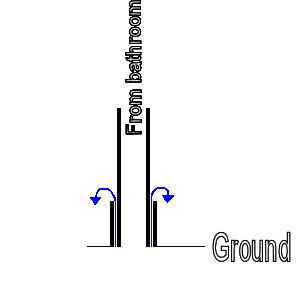Hello all,
I have an external unvented soil pipe running from my bathroom wall at the rear of my house, down into concrete at ground level.
My partner and I always have showers and I didn't notice a problem until we had a guest who wanted a bath. When the plug was pulled and the water started to drain, I noticed water seemed to be coming out from the base of the soil pipe.
On closer inspection the soil pipe disappears into a larger pipe, and there doesn't seem to be any kind of seal between the two. The volume of bath water must have been great enough to cause water to rise up over the top of this larger pipe and spill out onto the concrete. (See attached pic)
It looks like there may have been a cement or concrete collar-like join between the two long ago but this has since fallen away. The house was built in 1901.
Having never really inspected soil pipes before, is this a normal set up, and do you think would sealing the gap between the two pipes again solve the problem? Alternatively I suppose replacing the soil pipe with a new, vented one might help. The existing one elbows straight into the bathroom wall on the first floor.
Any tips advice would be much appreciated...
Thanks!
PS I'll try and take some photos when I get home later.[/img]
I have an external unvented soil pipe running from my bathroom wall at the rear of my house, down into concrete at ground level.
My partner and I always have showers and I didn't notice a problem until we had a guest who wanted a bath. When the plug was pulled and the water started to drain, I noticed water seemed to be coming out from the base of the soil pipe.
On closer inspection the soil pipe disappears into a larger pipe, and there doesn't seem to be any kind of seal between the two. The volume of bath water must have been great enough to cause water to rise up over the top of this larger pipe and spill out onto the concrete. (See attached pic)
It looks like there may have been a cement or concrete collar-like join between the two long ago but this has since fallen away. The house was built in 1901.
Having never really inspected soil pipes before, is this a normal set up, and do you think would sealing the gap between the two pipes again solve the problem? Alternatively I suppose replacing the soil pipe with a new, vented one might help. The existing one elbows straight into the bathroom wall on the first floor.
Any tips advice would be much appreciated...
Thanks!
PS I'll try and take some photos when I get home later.[/img]


